May 4th, 2016 · Comments Off on Exploring Islam: An Outsider’s Perspective – Introduction
Exploring Islam: An Introduction
August in Southwestern Ohio can be brutally hot and humid, so a bit of rain during cross country practice was always a welcome relief for my teammates and I. However, during one such storm, while the rest of us were embracing the cooling effect afforded by being soaked, I noticed that my friend Amir was running with his head almost to his chest, a marked difference from normally impeccable running form, actively avoiding the rain from hitting his face as much as possible. When we asked him what he was doing, he explained that he was fasting for Ramadan, and couldn’t drink anything until sunset – not even a few drops of rain that might make their way into his mouth and quench the inevitable thirst that comes from doing mile repeats under the midday summer sun. We all remarked at the strength that he must have had to endure that suffering at practice, while still pushing as hard as the rest of us, and then left it at that.
That was about the extent of my interaction with Islam growing up, with Amir being one of two Muslim students in my high school. It always remained a foreign religion to me, especially colored by the focus of the news at the time on the conflict in the Middle East and the doings of Islamic extremist groups. Though I was fortunate enough to have been raised to be tolerant and accepting of other’s faiths and ideas, this implicit bias towards associating Muslims with their depiction on the news pervaded my environment and ultimately masked any further attempt to understand what it truly meant to be “Muslim”. Furthermore, growing up in as homogenous a community as I did, perhaps I never truly felt the need to actively improve my, as Prof. Asani describes in Infidel of Love, religious literacy. However, as I have ventured further into this more heterogeneous world, I have begun to the realize the great disadvantage that being “illiterate”, as I was, conveys in terms of understanding the lived experience of my peers at school as well as those that I might interact with on a daily basis. Thus, it was my goal in taking this course to improve my religious literacy and chip away at the stereotypical, monolithic Islam that I had been exposed to growing up, to reveal the varied, diverse tradition that I knew existed underneath. In doing this, I also hoped to understand the various historical, sociopolitical, and artistic contexts that have shaped the multiple facets of Islam, as prescribed by the cultural studies approach to considering religion, as well as the role of the West in shaping these contexts. The art pieces depicted in this blog hopefully serve to convey my progressive debunking of these stereotypes throughout the course.
Of course, perhaps the most prominent of these stereotypes is what I would consider to simply be the idea of Muslims as the “dangerous other” or the “enemy within”, per as described by Prof. Asani in chapter two of Infidel of Love. In considering this caustic claim, it is important to first consider that, at its core, Islam is simply a religion of submission to one, and only one, God. A religion based in monotheism, it is perhaps not so different from the “Christian values” that many of the anti-Muslim proponents in the United States pit the tradition against. In fact, early Muslims, include the Prophet Muhammad himself, lived alongside Christians, Jews, and a host of other practitioners of various faiths. Furthermore, there is the idea that all of these people are Ahl al-kitab, or people of the book, or the Umm al-kitab – God’s prototypical scripture from which all of holy texts are derived. Similarly, many important figures are shared between these faiths, including Jesus, who appears as one of God’s prophets in the Islamic tradition. While the Prophet Muhammad is considered to be God’s final prophet, the others nonetheless still serve as role model Muslims to this day.
Similarly, in stark contrast to the imagery of Muslims as a “Trojan horse” sent to somehow destroy the United States from within, the basic tenets of Muslim identity, referred to as the Five (or Seven, if considered from the Sunni perspective) Pillars of Islam by the majority of Muslims, portray a tradition of peace and compassion, with followers united in their love for God. These include the shahadah, or testimony of faith, salat, or ritual prayer, zakat, or ritual almsigiving, sawm, or fasting during Ramadan, and finally the hajj, or pilgrimage to Mecca if one can afford it. While of course this idea of “five pillars” is very much dictated by the majority sect, in this case being a Sunni concept, with Shia followers adding in the condition of believing that Ali is the first imam, at their core, these rituals serve to promote a peaceful culture, again based on love, that many outside of the faith fail to recognize. I think this is best exemplified through the zakat, or ritual almsgiving, as depicted in the photo of outstretched hands offering food and money to a “beggar” from my first blog post. In doing this, one is able to purify themselves from greed, and thus share in their God-given wealth, ultimately serving to better their own community – something that most people, regardless of religion, would hopefully agree with. Thus, by gaining even the most basic understanding of what defines a person as a Muslim “with a capital M” as opposed to simply a “muslim”, or believer, one can begin to breakdown these preconceived notions surrounding the faith.
Of course, in simply comparing Islam as a single entity to other traditions, namely Christianity, one runs the risk of perpetuating the monolithic vision of Islam, failing to recognize the diversity of people and cultures within the tradition. Throughout the course, I was amazed to learn about the wild array of different means of practicing one’s faith in this tradition, from poetry to architecture. Often times, it seems that there is this conception of Islam as being like the white washed walls of a Saudi or Wahhabi mosque, devoid of color and other so-called “distractions”, when in fact it is quite the opposite. Even Quranic recitation, one of the hallmark practices of the faith, has a specific, almost music like quality to it, with even non Arabic speakers able to “understand” God’s power and beauty upon hearing or simply reciting the “sounds” of the verses, without necessarily understanding their meaning. Similarly, I created a comic depicting the Prophet’s interactions with Moses and Allah during the Mi’raj during which it is agreed that Muslims must pray five times per day for my second blog posting, in part to maintain this “accessibility” of the faith, especially for an outsider who might see the strong ritual practice in the faith as a bit intimidating. Thus, my use of a comic there hopefully helps to exemplify the role of the Prophet Muhammad within the tradition, acting as an intercessor between God and His people, while also showcasing the Prophet as a model Muslim, prostrating in his presence, but also being comfortable enough to debate with him on behalf of his followers, indicative of the strong, love-like bond that they share. In this way, I again hoped to show that Islam is not so much rigid or inflexible institution, but rather a fluid culture that is shaped by its surroundings. While that context can vary, such as varying the intonation of a Quran recitation depending on the time or place in which it is recited, in this case I attempted to put the tradition into terms that a relative outsider to any sort of religion, such as myself, might be able to understand.
Nowhere else is this context dependent interpretation of Islam more evident than with the differences in mosque architecture seen in Muslim communities throughout the world. Perhaps one of the more classic images of the mosque in the Western mindset is that of a domed building, with a minaret beside. Of course, these are simply constructions of western scholarship on the Middle East, with mosque architecture truly being contingent upon the local climate and environment, as well as a more local cultural context. This is clearly seen in considering mosques around the world, from pagoda-like architecture characteristic of the “far east” in Chinese mosques, to the open-air mud mosques of West Africa. In other words, while these mosques all serve as places of worship, and have the characteristic minbar from which the imam leads prayer, the qibla facing Mecca, and other features that have accumulated over Islam’s spread away from the Prophet’s home in Medina, they are also the product of local cultural influences. Of course, in that same vein, mosques have been used as symbols of nationalist power, ultimately serving to strip away the identity of a place and their local culture by imposing the architecture or style that the government in power sees fit. This is clearly seen in Southeastern Europe, particularly in the Balkans, where a cleansing of local mosque architecture and Muslim culture by the Saudis has served as not only a terrible loss of the history and culture of an entire people, but also to fuel the idea of a singular, fundamentalist Islam. Thus, I chose to combat this monolithic “other” created by these fundamentalist movements in my third blog posting, in which I created a sculpture of a mosque with components taken from different mosques architecture from around the world, forming a sort of “conglomerate mosque”.
Similarly, in contrast to the strict, conservative notions of Muslim culture bred by the western focus on fundamentalist movements, there is in fact a rich history of poetry, music, and literature among Muslim communities throughout the world, with poets such as Rumi being literally worshipped as religious figures. Of all of these traditions, one that particularly represents perhaps the antithesis of the fundamentalist movement (hence its promotion by many Western governments among Muslim youth) is that of Sufi mysticism, and the music and poetry in the form of the ghazal, or love poem, associated with it. The tradition promotes song and dance that can aid the practitioner in transcending this material world, losing one’s personal ego, and essentially entering the spiritual realm to become one with God. With poems from the likes of Hafez offering descriptions of wine-drinkers, taverns, and being intoxicated with love, the ghazal actively refutes the strict interpretations of the Quran by the ulama, or Islamic scholars, instead promoting this idea of passionate love, and the suffering associated with it, being the route to attaining spiritual enlightenment to be with God. This batin, or inner meaning, can perhaps only be attained through becoming God centric, as opposed to being human-centric and having forgotten God. This is exemplified in the Conference of the Birds, with many of the birds being unwilling to undertake the journey to God as a result of some insignificant material attraction, such as wealth or jewels. I personally felt that this Sufi focus on the losing the self and the focus on the material was highly relevant to people of all faiths and ideologies, especially in today’s material-driven world, and thus serves as a common ground through which outsiders might be able to relate to the tradition. Thus, I attempted to capture my own personal experience with passion and losing “the self” and the shedding of material wants and worries with my own ghazal in my fourth blog post.
Of course, in addition to considering the great diversity in traditions that exist beyond the fundamentalist monolith that captures the fear of so many Americans, it is also prudent to consider the context in which this fundamentalism itself developed. After all, per the cultural studies approach, one must consider religion as the result of the social and political factors that affect its practitioners. To that end, one must look towards the influence of colonialism and the imposition of westernization on many of Muslims societies. With this loss of independence, some, such as Iqbal, encouraged Muslims to essentially pull themselves up by their bootstraps essentially and re-find the “way” or their faith, thus alleviating the suffering they currently faced, as described in his Complaint and Answer poems. Others found in Islam a way to unify the populous to generate a nation-state in response to colonial powers. In Iran, for example, some took this westernization, and support of the oppressive Shah by the US (in an attempt to subvert the spread of communism in the region), as a sign of a return to the jahiliyya, or the return to the days of ignorance and savagery before the time of the Prophet. Thus, Islam came to serve as a political ideology, with a return to the “fundamentals” of Islam, as it was during the time of the Prophet, when Muslims were not in the “decline” depicted by many leaders in opposition to westernization, being one solution to the this loss of independence. To explore this further in my fifth blog post, I took one of the most contentious symbols of Muslims in America – the veil – and explored it’s role in nationalist movements, as well as the broader role of women’s bodies as essentially a battleground between the two sides. In failing to grasp the relevance of the veil as a part of a Muslim woman’s cultural identity, and ultimately removing a woman’s own agency over her body, western scholars have perhaps been to quick to characterize Muslims as “backwards” or behind in modernization, thus fueling the creation of the stereotypical “other” that the fundamentalist movement represents.
Taking this the example of the veil into consideration, perhaps the best way to combat Islamic fundamentalism is to first eliminate the idea of Muslims as the “other” and instead work to understand the socioeconomic and political contexts that generated these movements in the first place. In doing this, one begins to realize that this movement is perhaps more a result of poverty, lack of education, and oppression by colonial powers more than anything else. Perhaps more importantly though, it is imperative that the “religiously illiterate” understand the true diversity of Muslim communities across the globe, each with their own specific traditions, architecture, and rituals, such that they cannot all be grouped into one singular category. With Islamaphobia at some of its highest levels in recent years, as well as the upcoming presidential election (given a candidate who wishes to ban Muslims from immigrating to the United States), it is important to recognize the daily discrimination and stereotyping that many Muslim-Americans face on day-to-day basis. I thought this was captured well by Changez’s experiences in The Reluctant Fundamentalist, especially regarding his beard, so for my sixth and final blog post, I chose to create a collage of a influential African American Muslims hidden by a Muslim man’s beard, representative of a culture and religion that is an integral part of our nation’s history, but is instead overshadowed by fears over facial hair.
Personally, I am happy to report that I now have a better understanding of my teammate’s reasoning for suffering through those August practices. Much like Husayn refusing water during his final battle with Yazid as a representation for the collective suffering of the righteous people in the world, as depicted in the Persian play known as the Taziyeh, perhaps he too was attempting to suffering to show his devotion and deep love for his God. While that is perhaps a love and compassion that I will never quite know as a mere “scholarly observer”, I can now certainly appreciate its importance in the lives of Muslims, and the fact that it is truly the motivation behind much of these practices that might have seemed so foreign to me before. Hopefully through these blog posts, others might be able to look beyond the monolithic Islam that pervades the media in the United States, and reach that realization as well.
Tags: Uncategorized
May 4th, 2016 · Comments Off on Week 13: Muslims in the United States – Beyond the Beard
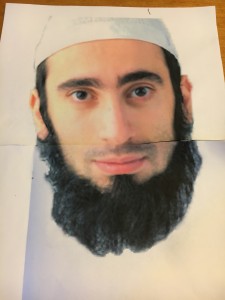
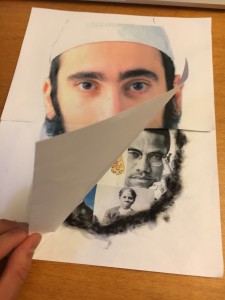
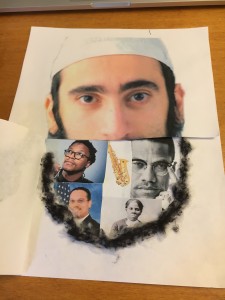
One particularly memorable scene in The Reluctant Fundamentalist occurs when Wainwright, one of Changez’s co-workers at Underwood Samson, suggests that his new beard is not making him “Mister Popular around the office” given the terrorist attacks of September 11th. Changez then replies that the beard is simply part of his culture, to which Wainwright replies “Jerk chicken is common where I come from…but I don’t smear it all over my face”. While this exchange certainly provides a bit of comedic relief in contrast to Changez’s serious personal struggles, the prejudice that Wainright conveys on behalf of their other coworkers is unfortunately all too real in today’s society. Much like the veil, the thick beard of a Muslim man, in keeping with model of the Prophet Muhammad who was also believed to have kept a beard, is perhaps one of the most prominent “symbols” of the monolithic “Islam” that breeds a culture of fear surrounding the faith in the US.
Of course, as discussed in Prof. Asani’s final lecture, this stereotypical image of a Muslim is but one of many faces of Islam in the United States. I was particularly taken by his description of how a large portion of the Muslim population is in fact African American, with many tracing their lineage to Muslim Africans brought to the Americas through the slave trade. This population then went on to have incredible influence on shaping modern culture and society in the United States. These contributions are clearly outlined in Aidi’s piece, Rebel Music, which describes not only Islam’s influence on jazz and the United States’ international relations (through “Jazz ambassadors” to both Soviet states, and more recently, to the Middle East), serving as a symbol of American democracy, but also in providing many African Americans a greater sense of identity and community during times of great discrimination and oppression.
In order to demonstrate the need to look beyond this stereotypical image of a Muslim and gain a more complete understanding of this tradition’s integral role in US history and culture, I took the first image that came up on a Google search for “Muslim man”, which was of course a man sporting the beard and the traditional clothing of an imam, and essentially gave him a “moveable” beard, which can be flipped to reveal a collage of a few prominent African American Muslims, including Malcom X and Keith Ellison, the first Muslim American elected to Congress. I also included Harriet Tubman, being one of the most widely recognized abolitionists, and a former slave herself, in order to represent how, as Aidi puts it, “Islam in the West and empire and racial exclusion are entwined.” In creating this piece, I hoped to not so much remove the beard as a means of diminishing the man’s identity as a Muslim, but rather to give the viewer the opportunity to actively look past it and see a small representation of the diversity of people that truly make up Muslims in the United States.
Tags: Uncategorized
May 4th, 2016 · Comments Off on Week 10 (and some of Week 12): The Veil as a Point of Control
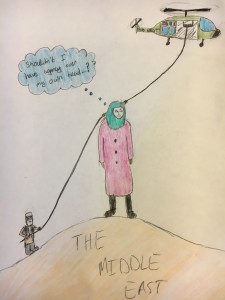
The veil is an incredibly loaded symbol with regard to Islam, representing at once the model, pious Muslim woman as well as the epitome of oppression and so-called “backwardness” in Muslim societies. As such, it has long been at the center of ideological debates between conservative, religious factions and more secular groups with leanings towards westernized culture and ideals. In a sense, women’s bodies, essentially serving as “transmitters of culture”, have become a point of control, or a battle-ground almost, between the two sides. This was exemplified during the Islamic Revolution in Iran, as depicted in Satrapi’s Persepolis, with the I have depicted this conflict here by showing a military-like helicopter, labeled “The West”, sporting US and British flags, flying above and left of a Muslim woman, attempting to the remove her veil (in this case her hijab). To the right of the woman, attempting to hold the hijab in place and pull it further down over her face, is an imam dressed in traditional clothes, representative of the more conservative Islamic state.
Of course, situated in the middle between these two sides is the woman herself, questioning why she is not able to do decide over what goes on her own head, with the decision to wear the veil essentially being made for her on either side (hence the thought bubble above her head). This is indicative of women’s lack of agency over their own bodies as a result of control from both sides of the conflict. On the one hand, there are certainly Muslim women who view the veil as a symbol of oppression, as it is depicted in Persepolis, and would like to see a world where women are veil-less, as in Sultana’s Dream. However, on the other hand, there is also a certain feminist orientalism, as Weber describes in her piece Unveiling Scherezade, whereby western notions of what it means to be feminist or empowered generates this idea of veiling as “backwards”, with Muslim feminists considered “less rational, less civilized, and less modern than the West”, totally discounting Muslim women’s reasons for wearing the veil. Often worn to show modesty while in public or while praying (as is required of both men and women in the Quran), or simply to as part of one’s identity as being Muslim, wearing the veil is not mutually exclusive with being against education and empowerment of women. In fact, some women feel that the veil is a symbol of their faith and focus on their own personal betterment, effectively serving as deterrent from men in an otherwise male-dominated society (per interviews and clips shown in lecture), or as Weber puts it, “protection from male lechery”. Ultimately, it is this depiction of the monolithic “Islam” as the “other” coupled with a general lack of understanding of Muslim traditions, that contributes to distrust of the West, and thus in part, fuels the radicalization movements that those promoting this sort of “un-veiling” likely aim to prevent.
Tags: Uncategorized
May 4th, 2016 · Comments Off on Week 9 Response – The Ghazal
On the Mountain
The dawn has nearly broken, the light slowly bestowing its warmth on the mountain
In the gray morning, my head lamp still serving as my personal guide on the mountain
Lungs burning, heart bursting in the thin air, I struggle upwards
Towards the object of my desire, stride by stride up the mountain
“Because it’s there”, George Mallory said
He who has died on the mountain
The frostbite, altitude sickness, and exhaustion
All things from which one cannot hide on the mountain
Far below in the valley, mountain-folk head to the tavern, drunk and in love, or perhaps to find it
While those in the alpine are intoxicated too, fueled by endorphins as they glide up the mountain
I wish to see your beautiful face, to have you here with me now to partake in this adventure
But then I gaze out over the forest below and am reminded we are together, side-by-side on the mountain
Occasionally the fickle weather gets between us
Such are the rules by which one must abide on the mountain
Now it is just Rory, left to the elements, with an empty pack
But a full heart, never alone, on the side of the mountain

Photo: Suffering (Heavy Pack) and Love (Mountains)
Here, I present a more personal, modern take on the Sufi love poem – the Ghazal. After reviewing some ghazals in section, I realized that the central themes of the poem – love and suffering as a result of that love – are clearly reflected in the experience of mountaineering, with the love of the mountains driving the climber through the adversity or suffering that it takes to reach the summit, referenced here as frostbite, burning lungs, bursting heart, etc in the second and seventh couplets of the poem.
Drawing inspiration from Hafiz, who, as Shayegan mentions in the Visionary Topography of Hafiz, always attempts to retain some “primeval focus” on the beloved throughout the poem, I attempted to tie in this idea of the light of creation as the rising sun, as well as a guiding, prophetic light as that from the climber’s headlamp, forming a “niche” in the darkness to guide the climber up the mountain towards his beloved, or the summit.
Of course, I also attempted to include the characteristic references to drunkenness and intoxication, comparing, in the fifth couplet, the more modern imagery of people in the valley perhaps heading to the pub in search of love, or to be with their love, whereas, by contrast, the climber is simply intoxicated with his love for the mountain and the endorphins that result from his pursuit of the summit.
In general, I attempted to maintain a sense of ambiguity within the poem, not only between the couplets themselves, with each one seemingly able to function on its own, but also with regard to the identity of the beloved, whether that be, another human, God, or the mountain itself. This is made clear in the sixth couplet, where the climber desires that his love be with him to share in this experience, but then, upon looking at the expanse of creation (ie the forest) below him, realizes that his love, in the divine sense, is all around him. Furthermore, the quote in the third couplet, regarding a famous alpinist’s reasoning for climbing, helps to critique modern notions of climbing as frivolous or “against the grain”, much like the tension between Sufism and the traditional ulama.
Overall, structurally speaking, I have tried to maintain the traditional conventions of the ghazal as outlined in Ali’s Ravishing Disunities: Real Ghazals in English, with the radif “ on/of the mountain”. In doing this, the reader is subtly reminded of the ultimate “beloved” in the poem – in this case the mountain. The qafiya is represented by the “-ide” syllable, serving to remind the reader of the “mountain side”, or that the journey – and suffering – to reach the beloved is ongoing. Finally, I attempt to bring myself, being the author, into the poem in the final couplet, as is customary with the Ghazal. I attempt to reference myself in the spiritual state that Sufi’s seek, having shed the self, and the material world, totally immersed in the mountain, or for Sufis, what might be considered God.
Tags: Uncategorized
March 22nd, 2016 · Comments Off on Week 6 Response – The Conglomerate Mosque

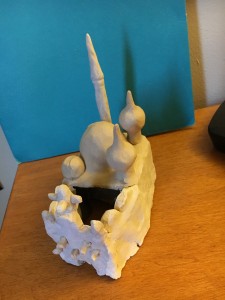
Mosques serve as centers of not only spiritual, but also often community, life for many Muslims. In addition to serving as a place of worship, many mosques have some sort of additional community function, ranging from something as simple as public gyms, to, in larger mosques, educational centers. However, beyond this basic function, the similarities between mosques in different areas of the world essentially end. Though perhaps originally modeled off of the Prophet Muhammad’s original home in Medina, where he would deliver sermons atop a small stool (later becoming the minbar) to a crowd of followers gathered in the courtyard under a small awning for shade, the mosques seen around the world today are to a large extent the product of the local culture and environment in which they are found.
This diversity in Islamic art and architecture is represented here with a miniature mosque sculpted out of clay built with a conglomeration of different, distinct components of mosques found throughout the world. The front of the mosque is made to resemble the Djeene mosque in Mali, with its smoothened mud surface and scaffolding framework, while the back is divided to represent both the large dome and minaret style common among Middle Eastern and Turkish mosques and the more rounded domes that are often seen adorning South or Southeast Asian ones. These differences represent a greater debate about the existence of one Islamic (with a capital “I”) art form rooted in spiritual meaning, as portrayed by Nasr in his piece, versus the idea of Islamic art as representative of the various art forms expressed by the diverse populations throughout the Muslim world, as put forth by Necipoglu in her piece. She emphasizes the uniqueness of Islamic art that has developed since the founding of the tradition, such as the incorporation of art unique to Hindu temples in to South Asian mosques, whereas Nasr appears more focused on early architectural styles. Without recognizing these various cultures and the multiple historical influences that shaped them, one runs the risk of ultimately playing into the interpretation of “Islam with a capital I”, whereby a sense of “otherness” is essentially created that plays into the modern notion of some monolithic power in the religion that seems to be perpetuated today.
Additionally, I purposefully left the this conglomerate mosque unpainted, with a plain, white exterior, to represent the destruction of beautiful mosques in the Balkans and elsewhere by the Wahhabi sect, in favor of their “hospital white box style” mentioned by Sells in his article on the topic, devoid of any local cultural character. This is indicative of a larger cultural cleansing being conducted by the Saudis throughout the region, again contributing to the otherness described above. Ultimately, this likely plays into the culture of fear associated with that sect, and the Islamic tradition in general, that seems to be so prevalent in Western societies.
Tags: Uncategorized
March 22nd, 2016 · Comments Off on Week 4 Response – The Many Meanings of the Mi’raj

The Mi’raj, or the story of the Prophet’s ascent to heaven, is marked by a number of interesting and colorful interactions that are well documented in Islamic art, as evidenced by the Seguy reading. However, one of the components of the story in some cultures that, though brought up in Chapter 3 of Infidel of Love, was not mentioned in the accounts of the Mi’raj assigned for discussion reading, was that of the negotiation between the Prophet and Allah for the salat to occur five times per day, instead of fifty. Given the smile and slight chuckle with which Prof. Asani presented this story in lecture, I felt it fitting to represent it in the form of a comic showing the Prophet – sporting a purple sweatband – “running” up and down the stairs between the final heaven where Allah resides, and the lower heaven where Muhammad encounters Moses. Finally, at the end of the comic, a reference is made to one of the many names of God, or God the compassionate and merciful, emphasizing God’s mercy in this case of not directing Muslims to pray fifty times per day.
Of course, though it might be humorous to consider the story of the Prophet’s ascension in this way, some of the deeper meanings of the Mi’raj can also be gleaned from this comic. This is mainly seen in the second and fifth frames, where the Prophet can be seen prostrating in the presence of God, who is represented here with brighter colors signifying His light that is the basis of all creation. Otherwise, He remains figureless, as no artist, especially a mediocre one like myself, would be able to capture the many facets of God and His beauty and power. Furthermore, this act of prostration is a clear representation of Muhammad’s complete submission to God, which is perhaps one of the central ideas put forth in the Mi’raj. As Prof. Asani describes in Infidel of Love, this submission represents complete clearing of the human ego, and all of the negative qualities associated with it, ultimately allowing Muhammad to “see” God everywhere. This is in keeping with the Prophet’s role as a model human, who other Muslims can emulate to best practice their faith and ultimately show their love for God.
Additionally, I chose to keep the language between God and Muhammad fairly casual when the two are interacting to help represent strength of the bond between the two figures. In a sense, it represents the deep love that the two share for each other, with Muhammad truly being God’s “beloved” and the chosen one to receive His message. This is further emphasized by the fact that Muhammad is able to visit God multiple times, perhaps serving as a testament to, as Prof. Asani suggests in Chapter Three of Infidel of Love, his special status as the chosen Prophet, whereas the lay Muslim might never be able to imagine meeting Him, or perhaps only during their final journey as a soul after death.
Tags: Uncategorized
March 22nd, 2016 · Comments Off on Week 2 Response – The Importance of Zakat
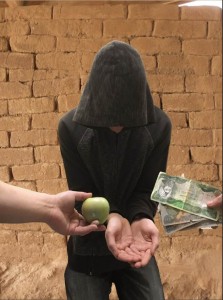
One of my main motivations for taking A&I 54 was to become better educated about the Islamic faith, and to perhaps gain a better understanding of what it means to be, as Professor Asani says, Muslim, “with a capital M”. While I was of course raised to be accepting of all peoples and faiths, and to not judge the entire faith of Islam on the actions of certain radical groups, growing up in a fairly homogeneous Midwestern town, I certainly experienced the caustic, uninformed response to Islam that Prof. Asani describes in Chapter Two of Infidel of Love. Although I fortunately never witnessed any overt acts of racism, any talk of Muslims from my peers at school seemed to generally be centered around “terrorism” or the latest report on the conflict in the Middle East from Fox News. Even at home, much of the supposedly “left-leaning” or “unbiased” media that I was exposed to still failed to present a picture of Islam beyond “extremist”. Thus, for me, the cultural studies approach used in the class to explore this faith has been incredibly informative, revealing the rich culture and compassionate, peaceful tradition that I was always vaguely aware of, but never fully exposed to in the environment that I grew up in.
To me, nothing is more representative of this compassion than the practice of zakat, or ritual almsgiving, which is considered to be one of the five pillars of Islam. I was taken by this act of charity incorporated into the foundation of the tradition, which I have not seen in any other faith given my limited experience with religion. With this in mind, I chose to represent the idea of zakat here with a photograph of a “beggar” with outstretched hands, being offered zakat in the form of money and food. The recipient remains faceless and only the hands of those doing the giving are shown in order to allow the viewer to imagine any number of people in the position of giver and recipient. After all, there is not one single “type” of Muslim – as myself and many other young people in the US were led to believe by portrayals of the religion in popular media.
Additionally, using Photoshop, I placed the photo against a background of an old, brick wall that could have been from Medina during the time of the Prophet Muhammad. In doing this, I hoped to convey the idea that this focus on social justice arises in part from the actions of the Prophet, such as the story described in Infidel of Love of him nursing a woman that would throw garbage at him back to health, ultimately converting her to a follower of his new faith. Given the Prophet’s position as the paradigm of an ideal Muslim, these acts of compassion serve as a basis for the modern focus on compassion within the Islamic faith today. The modern nature of the beggar’s clothes represents this link between the past and the present.
Tags: Uncategorized
March 21st, 2016 · 1 Comment
Welcome to Weblogs at Harvard. This is your first post. Edit or delete it, then start blogging!
Tags: Uncategorized









